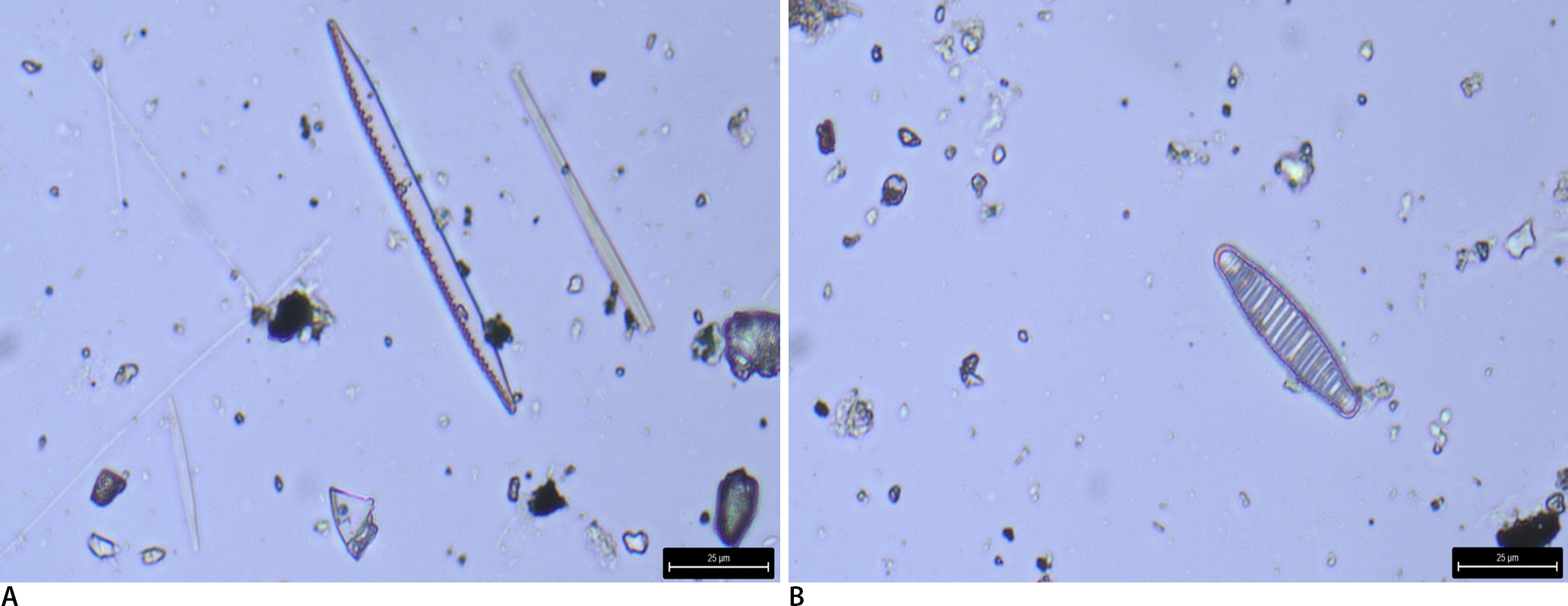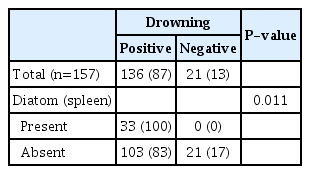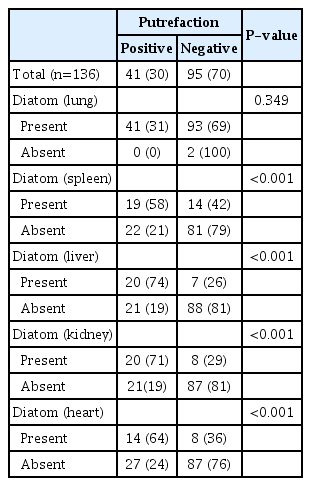The Significance of Detecting Diatoms in Spleen Tissue for the Postmortem Diagnosis of Drowning
Article information
Abstract
The aim of this study was to elucidate the diatomological investigation and the forensic role of spleen tissue in cases of drowning or non-drowning. Specimens of spleen tissue and other organ tissue from 136 drowning cases, as well as 21 cases where death resulted from causes other than drowning (acting as controls), were examined for the presence of diatoms. The diatom test was performed on all cases using the acid digestion method, involving fumed nitric acid on a hot sand bath. The presence of diatoms in spleen tissue was observed in drowning cases but not in non-drowning cases. Diatoms in spleen tissue showed a positive association with drowning (P=0.011). Among the 136 drowning cases, diatoms were most frequently found in lung tissue (n=134, 99%), followed by spleen (n=33, 24%), kidney (n=28, 21%), liver (n=27, 20%), and heart (n=22, 16%) tissues. Moreover, in 95 cases where putrefaction did not progress, diatoms were detected in spleen tissues in 14 cases, indicating that the highest detection rate among other enclosed organ tissues, excluding lung tissues. Furthermore, a significant correlation was observed between the presence of diatoms in spleen tissue and those in enclosed organs, including the liver, kidney, and heart, but not in lung tissues. Our results revealed a significant correlation between the presence of diatoms in spleen tissue and drowning. Thus, the present study provides evidence that the presence of diatoms in spleen tissue may be a reliable indicator of death by drowning.
Introduction
The postmortem diagnosis of drowning poses significant challenges in forensic medicine [1]. The identification of wet drowning is markedly supported not only by macroscopic autopsy findings such as external foam, frothy fluid in airways, emphysema aquosum, Paltauf's spots, pleural effusion, liquid in duodenum, and fluid in the sphenoid sinus but also by the detection of diatoms in the victims [2–4].
When water-containing diatoms is aspirated or swallowed, diatoms can enter the bloodstream from the lung vessels and migrate to other organs through the pulmonary alveoli or gastrointestinal tract [5–7]. The diatom test, considered the most reliable scientific method for diagnosing drowning, typically utilizes tissues from the lung, liver, and kidney [8,9]. Positive findings, indicating an acceptable number of diatoms from the same species in all three organs, strongly indicate drowning as the cause of death. While qualitative studies of diatoms in these three organs are frequently reported, similar studies involving other organs, such as the spleen, are rarely reported [5].
This study investigates the correlation between death by drowning and diatoms in spleen tissue in autopsy cases. Additionally, it aims to elucidate the diatomological significance and forensic role of spleen tissue in cases of drowning.
Materials and Methods
1. Sample collection
This study was approved by the institutional review board (906-20220120-BR-002-01) of the National Forensic Service of the Republic of Korea. Thirty grams of spleen, lung, liver, kidney, and heart tissues were collected from a total of 157 autopsy cases between January 21, 2021, and December 26, 2022. This study specifically focused on samples from 136 cases of drowning deaths examined at the National Forensic Service. Additionally, among deaths in the control group not associated with water, there were 10 cases of unnatural death, six cases of natural death, and five cases of unknown death. In the sample selection, cases involving open wounds and those associated with baths and swimming pools were excluded from the drowning cases.
2. Diatom test
Tissues from the spleen, lung, liver, kidney, and heart were cut into small pieces and subjected to overnight digestion with HNO3. The resulting digested product underwent centrifugation at 2,500 rpm for 10 minutes. The precipitate was washed twice with distilled water and then re-suspended in 100 µL of distilled water in preparation for transfer to a microscope slide [6]. A positive result was determined if diatoms were detected at a concentration of more than 2 frustules/g in each organ tissue.
3. Statistical analysis
Statistical analyses were performed using SPSS version 22.0 software (IBM Corp., Armonk, NY, USA). The significance of the correlation between drowning and the diatomological investigations was determined by χ2 test. Results were considered statistically significant for P<0.05.
Results
1. Correlation between death by drowning and diatoms of spleen tissue in autopsy cases
We performed an analysis to explore the correlation between death by drowning and the presence of diatoms in spleen tissue in autopsy cases. Fig. 1 shows a representative image of diatoms in organ tissues using the nitric acid digestive method. The occurrence of diatoms in spleen tissue was observed in drowning cases but not in non-drowning cases. Diatoms in spleen tissue were found in 33 of the 157 autopsy cases (21%), showing a positive association with drowning (P=0.011) (Table 1). The relationship between diatoms in spleen and drowning demonstrated a sensitivity of 24%, specificity of 100%, a positive predictive value of 100%, and a negative predictive value of 17% (Table 1). Moreover, among the 136 drowning cases, diatoms were most frequently observed in lung tissue (n=134, 99%), followed by spleen (n=33, 24%), kidney (n=28, 21%), liver (n=27, 20%), and heart (n=22, 16%) tissues.
2. Correlation between putrefaction and diatoms in organ tissues obtained from cases of drowning autopsy
We performed an investigation into the correlation between putrefaction and the presence of diatoms in organ tissues obtained from cases of drowning autopsy. The putrefaction index was evaluated by two medical examiners, and above the bloating stage was evaluated as positive. In the present study, our results indicated a positive correlation between putrefaction and the presence of diatoms in spleen, liver, kidney, and heart tissues (all P<0.001). However, there was no association between putrefaction and the presence of diatoms in lung tissue (P=0.349) (Table 2).
3. Correlation between diatoms of spleen tissue and those of other organ tissues in autopsy cases
We conducted an analysis to explore the correlations between diatoms in spleen tissue and those in other organ tissues, including lung, liver, kidney, and heart, in autopsy cases. As shown in Table 3, diatoms in spleen tissue exhibited a positive correlation with those in liver, kidney, and heart tissues (all P<0.001) but not with those in lung tissue (P=0.420) (Table 3).
Discussion
The World Health Organization defines drowning as the ‘process of experiencing respiratory impairment from submersion/immersion in liquid’ [10]. The primary mechanism behind drowning is rapid and persistent hypoxemia, resulting from the introduction of water or other liquids into the airway [11–13]. Proving drowning as a cause of death postmortem is notably challenging [3], prompting the proposal of various tests to substantiate such conclusions [8,14]. Among these, the diatom test stands out as one of the more informative and reliable laboratory tools supporting the diagnosis of drowning, complementing characteristic macroscopic autopsy findings. However, the specificity and sensitivity of diatom tests have been subject to criticism and controversy [15]. The forensic significance of diatom tests needs elucidation in cases of suspected drowning. This study revealed a significant correlation (P=0.011) between the detection of spleen diatoms and drowning, underscoring the importance of examining spleen diatoms as a mandatory factor in diagnosing drowning. However, our study did not include a control group found in water but not diagnosed as drowning. Including such a control group in future studies could enhance the reliability of our findings.
The spleen, a substantial lymphoid organ, plays a vital role in immune function, bacterial and antigen filtration, and the removal of aging red blood cells [16]. In a previous study, it was reported that in cases where obtaining blood is challenging, assessments related to starvation, diabetes, and chronic alcoholism can be estimated by analyzing ketone bodies using spleen tissue in autopsy cases [16]. In this study, we assessed diatom detection in organ tissues, including the lung, liver, kidney, heart, and spleen in autopsy cases. Our results showed that among the 136 drowning cases, diatoms were most frequently observed in lung tissue (99%), followed by spleen (24%), kidney (21%), liver (20%), and heart (16%) tissues. Notably, spleen exhibited the second-highest detection rate among the organ tissues. Therefore, our results suggest the importance of examining diatoms in spleen tissue for the identification of drowning during autopsy.
The evolution of decomposition in a liquid environment is influenced by various factors, including temperature, currents, interactions between the remains and the physical environment, and animal scavenging. Although postmortem putrefaction occurs similarly to that in a dry environment, variations in bacterial flora and the presence of an anaerobic atmosphere can modify typical chemical processes. With prolonged postmortem intervals, these alterations may lead to the transformation of fats into adipocere [17]. Decomposition changes play a crucial role in determining the cause of death in drowning cases during autopsy. Despite this, the correlation between putrefaction and diatom presence in organ tissues has not been previously reported. In our study, putrefaction demonstrated a significant correlation with the presence of diatoms in spleen, liver, kidney, and heart tissues (all P<0.001), while no such correlation was observed in lung tissues (P=0.349). Notably, in cases without putrefaction, the detection rate of diatoms in spleen tissues surpassed that of other enclosed organ tissues, excluding lung tissues (Table 2). Thus, these results suggest a relationship between putrefaction in drowning autopsies and diatom detection in enclosed organ tissues. The diagnosis of drowning involves several considerations, and diatom testing remains a subject of controversy. According to our results, the examination of spleen diatoms is deemed necessary, but caution is essential in interpreting findings from decomposing bodies. Future studies should focus on researching the movement and detection of diatoms during the process of putrefaction.
The pathway through which diatoms enter the bloodstream is intricately linked to drowning. Diatoms present in water can be inhaled into the pulmonary alveoli, traversing the blood–air barrier and entering the bloodstream. As the heart continues pumping until death, diatoms in the blood can reach distant organs. The presence of diatoms in internal organs strongly suggests death by drowning [5,18]. Some forensic experts propose that diatoms in the lungs may indicate contamination in drowning investigations. However, under rigorous contamination control measures, diatoms are likely to be found in the lungs of drowning victims, as well as in the lungs of individuals submerged in water for other causes of death [5]. The detection of diatoms in systemic circulation organs might be more suitable for the diatom test, particularly when efforts are made to avoid exogenous contamination [5]. In previous studies, diatom detection in the spleen, a systemic circulation organ, has been limited to animal experimental models [5,11,19]. In contrast, our study involved diatom testing using spleen tissue obtained from human autopsies. Our results revealed a positive correlation between diatoms in spleen tissue and those in liver, kidney, and heart tissues (all P<0.001), while no such correlation was observed with lung tissue (P=0.420) (Table 3). These findings suggest an association between diatoms detected in spleen tissue and those in enclosed organ tissues, excluding the lung. Hence, in cases of drowning where diatoms are detected exclusively in lung tissue, it is imperative to consider other contributing factors.
In conclusion, our data demonstrated a significant correlation between the presence of diatoms in spleen tissue and drowning. Additionally, we observed significant correlations between diatoms in spleen tissue and those in enclosed organ tissues, as well as with putrefaction. The detection of diatoms in spleen tissue emerges as a valuable indicator of death by drowning in autopsy cases.
Notes
Conflicts of Interest
Young San Ko and Jin-Haeng Heo, contributing editors of the Korean Journal of Legal Medicine, were not involved in the editorial evaluation or decision to publish this article. All remaining authors have declared no conflicts of interest.
Acknowledgments
This work was supported by the National Forensic Service (NFS2024STR03), Ministry of the Interior and Safety, Republic of Korea.




